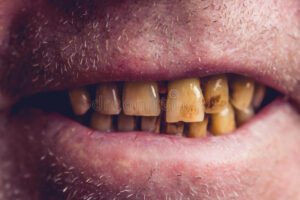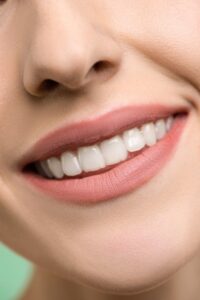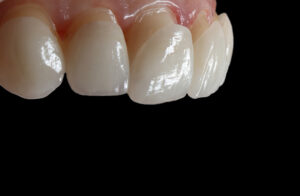Exploring Discolouration – causes, prevention and treatments
What is discolouration?
It means teeth that are no longer as white or bright as they were or are expected to be. They may develop white or dark spots or turn from white to yellow, grey, black or brown.
There are 3 main reasons why your teeth might not be the pearly white of your Hollywood-style dreams:
- Extrinsic: the outer layer (enamel) is stained by something coming in to contact with the outside of your teeth
- Intrinsic: the inner layer (dentin) becomes more yellow or darkens. Caused by changes inside the teeth or body
- Ageing: enamel naturally thins with age, showing more of the yellow dentin underneath. This can also be why some people think their teeth look translucent. Damaged teeth can also become discoloured
A dentist can tell the cause of discolouration by examining the teeth.
Why are my teeth yellow?
- Genetics: you may have a naturally thin white outer layer of enamel, exposing more of the yellow dentin layer underneath
- Ageing: The white enamel becomes thinner
Why are my teeth brown / brown stains between teeth?
- Smoking stains teeth
- Certain food and drinks like tea, coffee and red wine cause staining
- Poor brushing means failure to remove plaque on teeth, which can lead to decay
Why do my teeth have white spots?
- An intake of too much fluoride in drinking water, mouth wash or tooththpaste in children under the age of eight, can cause Fluorosis, which may cause white spots or other discolouration
Why are my teeth grey or black?
- Tooth decay (pulp necrosis) due to poor oral hygiene
- Chewing betel nuts
- Exposure to certain minerals can cause a black line on teeth
Why are my teeth purple?
- Have you been drinking red wine?
- Eating blackberries or beetroot can cause staining
Most likely causes of stained, discoloured teeth

- There are many drink and food culprits. These are the most common:
- Smoking or chewing tobacco
- Coffee, tea, red wine and cola
- Certain foods e.g. curry, apples and potatoes
- Poor oral hygiene: not brushing well enough to effectively remove the plaque on the surface of the teeth causes decay and staining
- Mouth washes containing chlorhexidine
- Some dentistry materials e.g. amalgam fillings can cause teeth to turn grey or even black
- Some medication can cause teeth to discolour e.g. antibiotics tetracycline and doxycycline if given to children under the age of eight. Also Antihistamines(like Benadryl), antipsychotic drugs, and drugs for high blood pressure
- Certain diseases and conditions such as certain infections in pregnant women can affect the development of the baby’s enamel, causing discolouration.
- Treatment for cancer such as radiation of the head and neck or chemotherapy
- Trauma: Damage to teeth, for example due to a fall, can cause discolouration in both children and adults
- Ageing: Over time the white outer coating of teeth (enamel) can wear away, leaving the more yellow dentin layer underneath looking more noticeable
- Genetics: Some people just naturally have thicker, whiter enamel than others (I know, this one just seems unfair!)
- Environment: An intake of too much fluoride, either in drinking water or swallowing fluoride in mouth washes, rinses or toothpaste can cause fluorosis – discolouration of teeth
Top 3 tips to keep your teeth pearly white:
- Brush properly and regularly – twice per day for two minutes. See our guide to brushing effectively (Insert link to How to brush your teeth)
- Avoid starting or decide to stop behaviours that cause staining like smoking or drinking excessive coffee, tea or red wine. Worst case: swill your mouth with water afterwards
- Visit your dentist and hygienist at least every 6 months. If you notice sudden tooth discolouration for no reason, visit sooner
 How to whiten teeth
How to whiten teeth
Okay, so it could be that you’ve followed all the dental care advice and you still don’t have that stand out smile you’re hoping for.
Or perhaps you just want to cut corners and achieve the Hollywood smile without all the effort.
You may have been tempted by the TikTok videos showing people applying hydrogen peroxide, the commonly used hair bleach straight to their teeth (to the silent screams of dentists all over the world shouting Please do not do that!!!) and want to check out the alternatives.
Whichever is the case for you, what we need to know is:
The ultimate guide to whiter teeth
-
DIY teeth whitening toothpastes and mouthwashes
How do they work:
Whitening toothpastes tend to use abrasives and polishers to effectively scrub the stains away. They also contain gentle chemical bleaching agents to whiten and some have ‘optic brighteners’ that reflect blue white, creating the illusion of whiter teeth, a bit like some washing powders for whites.
How effective are they?
They can be effective at removing some surface stains. As the bleach levels allowed in these products are too weak to b ultra-effective so don’t expect a drastic make-over. More of a minor improvement and long-term preventative treatment that keeps your mouth healthy.
Watch outs: Some whitening toothpaste abrasives can potentially scrub away the white enamel, causing sensitivity and exposing more of the yellow dentin underneath. The exact opposite of the result you want! https://www.bbc.co.uk/news/health-48216116
How much do they cost? Budget friendly: A low cost option: £6-£12
-
DIY whitening strips
How do they work? They are strips that have been pre-coated with a gel that contains bleach. They stick straight on to your (dry) teeth and need to be worn continually for a period, usually an hour. Some of them aren’t very noticeable, so you can even wear them whilst out and about (apparently!)
How effective are they?
They will deliver gradual results – no magic makeovers here. Best results seen when used in conjunction with a whitening toothpaste.
Watch outs: They contain more bleach than toothpaste, so need to be used no more than every two weeks. Otherwise you risk causing sensitivity and even damage.
They won’t work well for crowded or crooked teeth.
How much do they cost? They range from £20-45 for 14 treatments
-
DIY Teeth Whitening lights
How do they work? The claim; These use dentist technology to activate a whitening gel that’s painted on to the surface of the teeth. The whitening gel usually contain hydrogen peroxide or a similar derivative called carbamide peroxide. These chemicals contain hydrogen and nitrogen molecules , which when activated split up, causing a deep cleaning action. This activation can be caused by exposure to your teeth, high temperatures or UV light.
How effective are they? They do nothing to activate teeth whitening gels and are a gimmick.
Watch outs: Most of the DIY lights are LED blue lights, not UV light. So they don’t actually activate the whitening gel at all
The only UV lights that are guaranteed to work, are those provided by a dentist
How much do they cost: Budget friendly options are available at under £15 – but there’s a reason they’re cheap!
-
DIY whitening kits
How do they work?
These usually involve a teeth whitening agent applied to a dental tray that fits over the teeth and is worn for a period, often several hours at a time. The agent will contain very low levels of the bleach hydrogen peroxide or carbamide peroxide.
The bleach whitens the enamel, the outer surface of the tooth
Are they effective?
Home kits can only use very low levels of peroxide, so they are not as effective as those applied in a dentist surgery.
Watch out: May cause sensitive teeth and gums. This should only be temporary and may be improved by using a toothpaste for sensitive teeth.
How much do they cost?
Varies between £40-90 for up to 8 treatments
-
Dentist Whitening treatment
How does it work?
In the same way as DIY kits where a whitening bleach is applied to the teeth, usually for two 1-hour sessions, 3-4 days apart. However, dentists are allowed to use much higher concentrations of bleach. This penetrates the outer enamel, also bleaching the yellow dentin layer inside.
EU regulations allow a 6% hydrogen peroxide concentration to be used by dentists.
American dentists are allowed to use 25% hydrogen peroxide concentration. However this can cause very sensitive teeth and even burn gums.
Laser whitening may be used, which may take an hour. Then the trays or dental moulds will need to be worn with bleach for an additional 30 mins each day for up to 14 days afterwards.
Is it effective: Yes, proven to be the most effective method. It’s also the best way to even up colour, perhaps focusing on a tooth that is particularly discoloured.
It’s usual to see an improvement of 5-10 shades on a teeth whitening chart. This depends on the thickness of your tooth enamel. The thinner it is, the less effective the results may be.
Watch outs: Any fillings, bridges, crowns or implants won’t change colour. You may need to have these replaced or treated separately.
How much does it cost? Not for the feint hearted. You’ll need deep pockets as prices start from £500
-
Dentist provided trays or mouthpiece to use at home
How does it work?
A mouthpiece or tray is moulded to fit your teeth exactly and whitening gel is provided for use at home. Usually to be worn overnight for 2-3 consecutive nights, perhaps every few months.
Is it effective? Yes, generally thought to be the most effective, safe way to whiten teeth.
Watch outs: None really. A custom made tray minimises the risk of the gel coming in to contact with other parts of the mouth. May still cause sensitivity but generally temporary.
How much does it cost? £200-£300 but then replacement gel can be bought online and the mouthpiece will generally last for years.
-
Porcelain or composite-resin veneers
 If teeth are severely stained, too sensitive to handle whitening or you also want to change their shape and size, veneers may be the only real option.
If teeth are severely stained, too sensitive to handle whitening or you also want to change their shape and size, veneers may be the only real option.
How do they work?
Dental veneers are thin coverings that are placed over the front part of a tooth. There are two types:
Porcelain veneers: Custom-made wafer-thin shells that fit over a tooth. They look completely natural, are hard-wearing and quite stain-resistant. However this is a high-cost solution, costing thousands
Composite-resin veneers: made from a tooth-coloured, hard-wearing material that is bonded to the tooth. Less tooth enamel needs to be removed to fit these compared to porcelain and they are easier to repair and cost less too
Veneers are not suitable for everyone though.
- Other, more natural ways to whiten teeth
Some people swear by swilling or ‘pulling’ coconut oil around their mouth or through their teeth
How does it work?
Put 1 tablespoon of coconut oil in your mouth. Swill it around the mouth, pulling it through teeth for 15-20 minutes, then spit it out in to the bin (to avoid clogging up drainage pipes). Or it can be used to make toothpaste.
Coconut oil is the richest source of lauric acid known to man. Our bodies break this down in to a substance called monolaurin. This and lauric acid are both known to be effective at killing harmful bacteria, viruses and fungi in the body.
In the mouth it kills a bacteria called streptococcus mutans, the main cause of tooth decay.
Is it effective?
A recent report https://pubmed.ncbi.nlm.nih.gov/25838632/ demonstrated a significant decrease in both plaque and gum disease after 30 days of using the coconut oil pulling technique.
How much does it cost?
Very budget friendly: Under £5
How to whiten sensitive teeth

Daily
- Use a whitening toothpaste especially for sensitive teeth
- Avoid food and drink that stain teeth e.g. red wine, tea and coffee or at least swill your mouth with water just afterwards
Before starting any whitening regime
- Visit your dentist. Make sure there aren’t any underlying issues that need attention first
- Seek their advice on the best options available for you
Options for whitening sensitive teeth:
- There are some DIY at home whitening kits that claim to be especially for sensitive teeth. Make sure you read the labels warning about sensitivity to help you choose the right one
- Your dentist can provide professional whitening using gels and desensitisers to reduce sensitivity and monitoring the level of exposure to the hydrogen or carbamide peroxide that causes irritation
- Coconut oil pulling option (see above)
How to whiten teeth with a brace
If your brace brackets are bonded to your teeth, then most whitening procedures are not recommended. Firstly because the enamel covered by the brackets will not be whitened, so you risk a two-toned look when you have your braces removed. Secondly, because whitening products contain bleaching agents that can cause sensitivity, which isn’t ideal when you’re in the process of shifting the position of your teeth.
So top tips for keeping teeth white whilst wearing braces:
- Good dental hygiene: Brush twice per day for two minutes, also using an interdental brush to really get in to those nooks and crannies. Avoid hard bristles to safeguard your enamel and gums
- Use dental floss and really get down in between the gums and teeth
- Use a fluoride toothpaste, ideally non-whitening as these can be too abrasive and damage enamel. Fluoride provides the best protection for teeth






